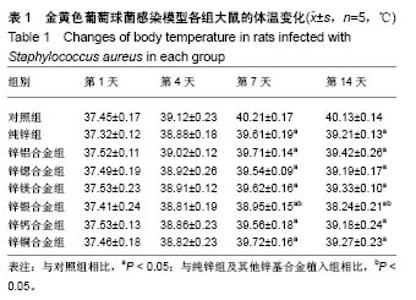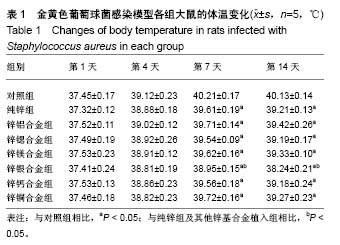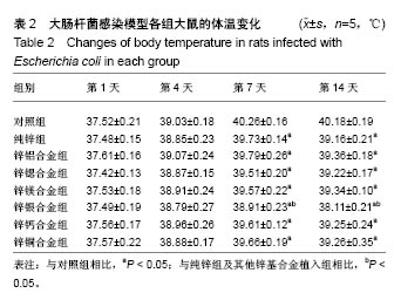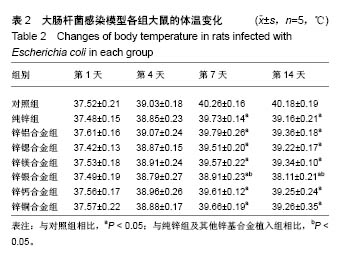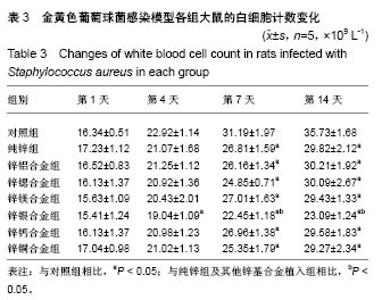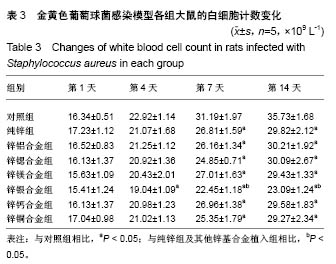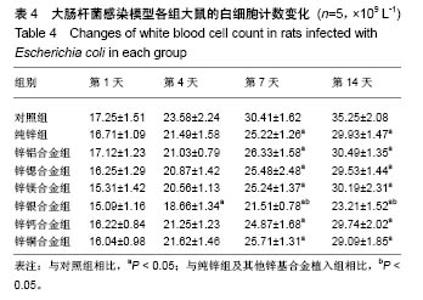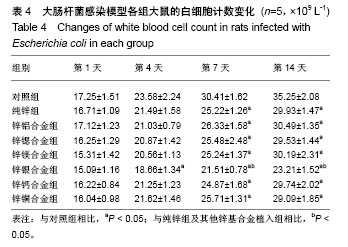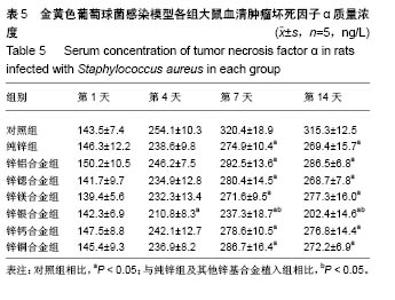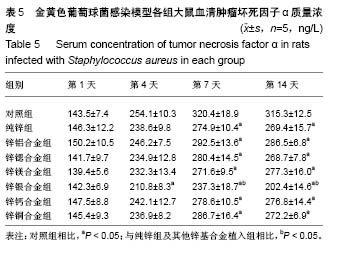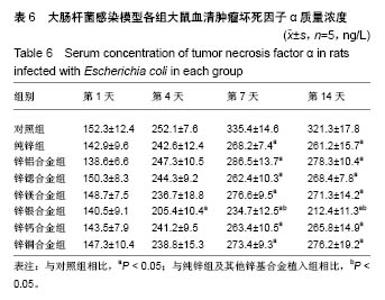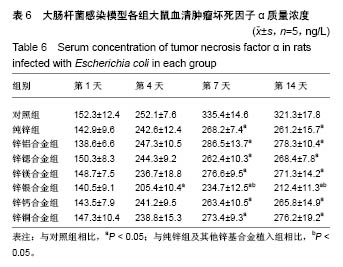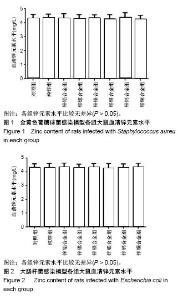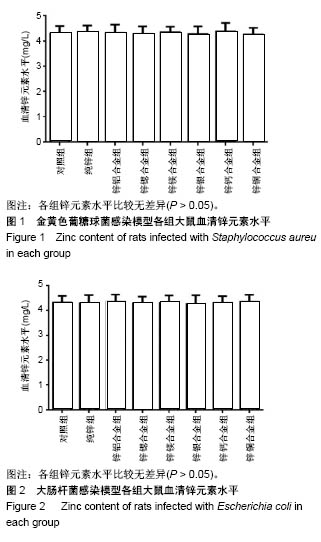Chinese Journal of Tissue Engineering Research ›› 2019, Vol. 23 ›› Issue (14): 2196-2201.doi: 10.3969/j.issn.2095-4344.1664
Previous Articles Next Articles
Antibacterial properties of biodegradable zinc alloys in vivo
Xie Zhong, Yang Mingzhi, Xue Jingbo, Chen Yong, Peng Lijun, Cai Bin, Zhang Yangyang
- Department of Spine Surgery, the First Affiliated Hospital of University of South China, Hengyang 421001, Hunan Province, China
-
Contact:Yang Mingzhi, MD, Chief physician, Department of Spine Surgery, the First Affiliated Hospital of University of South China, Hengyang 421001, Hunan Province, China -
About author:Xie Zhong, Master, Attending physician, Department of Spine Surgery, the First Affiliated Hospital of University of South China, Hengyang 421001, Hunan Province, China
CLC Number:
Cite this article
Xie Zhong, Yang Mingzhi, Xue Jingbo, Chen Yong, Peng Lijun, Cai Bin, Zhang Yangyang. Antibacterial properties of biodegradable zinc alloys in vivo[J]. Chinese Journal of Tissue Engineering Research, 2019, 23(14): 2196-2201.
share this article
| [1] Sheikh Z, Najeeb S, Khurshid Z, et al. Biodegradable Materials for Bone Repair and Tissue Engineering Applications. Materials(Basel).2015;8(9):5744-5794.[2] 岑超德,罗聪.可降解组织工程骨材料及其血管化研究:问题与应用前景[J].中国组织工程研究,2014,18(21):3391-3397.[3] Song R,Murphy M,Li C, et al. Current development of biodegradable polymeric materials for biomedical applications. Drug Des Devel Ther.2018;12:3117-3145.[4] 李君涛,陈周煜.可降解生物医用材料研究现状与展望[J].新材料产业,2016,18(1):32-35.[5] Ginebra MP,Espanol M,Maazouz Y,et al.Bioceramics and bone healing.EFORT Open Rev.2018;3(5):173-183.[6] 医用高分子材料及其相关产品的临床应用[J].中国组织工程研究与临床康复,2011,15(47):8877-8878.[7] Yoshii H,Futsusaka H,Tsuchigame N,et al.An in-vitro test of thyroid function by T3 Uptake (MAA) Kit (author's transl). Horumon To Rinsho.1980;28(4):443-446.[8] Bertesteanu S,Chifiriuc MC,Grumezescu AM,et al.Biomedical applications of synthetic, biodegradable polymers for the development of anti-infective strategies.Curr Med Chem. 2014;21(29):3383-3390.[9] Seitz JM,Durisin M,Goldman J,et al.Recent advances in biodegradable metals for medical sutures: a critical review.Adv Healthc Mater.2015;4(13):1915-1936.[10] Prakasam M,Locs J,Salma-Ancane K,et al. Biodegradable materials and metallic implants - a review. J Funct Biomater. 2017;8(4):44.[11] Fukunaka A, Fujitani Y.Role of Zinc Homeostasis in the Pathogenesis of Diabetes and Obesity.Int J Mol Sci. 2018;19(2).pii: E476. doi: 10.3390/ijms19020476.[12] Suzuki T,Kajita Y,Katsumata S,et al. Zinc Deficiency Increases Serum Concentrations of Parathyroid Hormone through a Decrease in Serum Calcium and Induces Bone Fragility in Rats. J Nutr Sci Vitaminol (Tokyo). 2015;61(5): 382-390.[13] Liu H,Li W,Jia S,et al.Puerarin and zinc additively prevent mandibular bone loss through inhibiting osteoclastogenesis in ovariectomized rats.Histol Histopathol.2017;32(8):851-860.[14] Zhao L, Zhang Z, Song Y, et al. Mechanical properties and in vitro biodegradation of newly developed porous Zn scaffolds for biomedical applications.Mater Design.2016;108:136-144.[15] 冯相蓺,周超,张海军.生物可降解锌基金属材料研究进展[J].材料导报,2018,32(z1):188-191,195.[16] Zackular JP,Moore JL, Jordan AT, et al.Dietary zinc alters the microbiota and decreases resistance to Clostridium difficile infection.Nat Med.2016;22(11):1330-1334.[17] Murphy RA, Okoli O, Essien I, et al. Multidrug-resistant surgical site infections in a humanitarian surgery project. Epidemiol Infect.2016;144(16):3520-3526.[18] 贾曼,金文姬,李娜,等.骨科患者手术植入物感染的相关因素分析与预防[J].中华医院感染学杂志,2017,27(23):5391-5394.[19] Murray CK,Obremskey WT,Hsu JR,et al.Prevention of infections associated with combat-related extremity injuries.J Trauma.2011;71(2 Suppl 2):S235-S257.[20] Zberg B,Uggowitzer PJ, Loffler JF. MgZnCa glasses without clinically observable hydrogen evolution for biodegradable implants.Nat Mater.2009;8(11):887-891.[21] Bowen PK,Guillory RN, Shearier ER,et al.Metallic zinc exhibits optimal biocompatibility for bioabsorbable endovascular stents.Mater Sci Eng C Mater Biol Appl. 2015; 56:467-472.[22] Wang X,Lu HM,Li XL,et al.Effect of cooling rate and composition on microstructures and properties of Zn-Mg alloys.Trans Nonferrous Met Soc China.2007;(S1):122-125.[23] Murni NS,Dambatta MS, Yeap SK,et al.Cytotoxicity evaluation of biodegradable Zn-3Mg alloy toward normal human osteoblast cells. Mater Sci Eng C Mater Biol Appl. 2015;49: 560-566.[24] Bowen PK,Seitz JM,Guillory RN,et al.Evaluation of wrought Zn-Al alloys (1, 3, and 5 wt % Al) through mechanical and in vivo testing for stent applications.J Biomed Mater Res B Appl Biomater.2018;106(1):245-258.[25] Sikora-Jasinska M,Mostaed E,Mostaed A,et al.Fabrication, mechanical properties and in vitro degradation behavior of newly developed ZnAg alloys for degradable implant applications.Mater Sci Eng C Mater Biol Appl. 2017;77: 1170-1181.[26] Tang Z,Niu J,Huang H,et al.Potential biodegradable Zn-Cu binary alloys developed for cardiovascular implant applications.J Mech Behav Biomed Mater.2017;72:182-191.[27] Li HF,Xie XH,Zheng YF,et al.Development of biodegradable Zn-1X binary alloys with nutrient alloying elements Mg, Ca and Sr.Sci Rep.2015;5:10719.[28] 项荣,丁栋博,范亮亮,等.氧化锌的抗菌机制及其安全性研究进展[J].中国组织工程研究,2014,18(3):470-475.[29] 张波,周潘宇,邱超,等.医用可降解锌合金材料抗菌性能及细胞相容性的体外实验研究[J].中华损伤与修复杂志(电子版), 2016, 11(3):191-197.[30] Tapiero H,Tew KD.Trace elements in human physiology and pathology: zinc and metallothioneins. Biomed Pharmacother. 2003;57(9):399-411.[31] Redmile-Gordon M,Chen L. Zinc toxicity stimulates microbial production of extracellular polymers in a copiotrophic acid soil.Int Biodeterior Biodegradation.2017;119:413-418.[32] Vojtech D,Kubasek J,Serak J,et al.Mechanical and corrosion properties of newly developed biodegradable Zn-based alloys for bone fixation.Acta Biomater.2011;7(9):3515-3522. |
| [1] | Zhang Tongtong, Wang Zhonghua, Wen Jie, Song Yuxin, Liu Lin. Application of three-dimensional printing model in surgical resection and reconstruction of cervical tumor [J]. Chinese Journal of Tissue Engineering Research, 2021, 25(9): 1335-1339. |
| [2] | Zeng Yanhua, Hao Yanlei. In vitro culture and purification of Schwann cells: a systematic review [J]. Chinese Journal of Tissue Engineering Research, 2021, 25(7): 1135-1141. |
| [3] | Xu Dongzi, Zhang Ting, Ouyang Zhaolian. The global competitive situation of cardiac tissue engineering based on patent analysis [J]. Chinese Journal of Tissue Engineering Research, 2021, 25(5): 807-812. |
| [4] | Wu Zijian, Hu Zhaoduan, Xie Youqiong, Wang Feng, Li Jia, Li Bocun, Cai Guowei, Peng Rui. Three-dimensional printing technology and bone tissue engineering research: literature metrology and visual analysis of research hotspots [J]. Chinese Journal of Tissue Engineering Research, 2021, 25(4): 564-569. |
| [5] | Chang Wenliao, Zhao Jie, Sun Xiaoliang, Wang Kun, Wu Guofeng, Zhou Jian, Li Shuxiang, Sun Han. Material selection, theoretical design and biomimetic function of artificial periosteum [J]. Chinese Journal of Tissue Engineering Research, 2021, 25(4): 600-606. |
| [6] | Liu Fei, Cui Yutao, Liu He. Advantages and problems of local antibiotic delivery system in the treatment of osteomyelitis [J]. Chinese Journal of Tissue Engineering Research, 2021, 25(4): 614-620. |
| [7] | Li Xiaozhuang, Duan Hao, Wang Weizhou, Tang Zhihong, Wang Yanghao, He Fei. Application of bone tissue engineering materials in the treatment of bone defect diseases in vivo [J]. Chinese Journal of Tissue Engineering Research, 2021, 25(4): 626-631. |
| [8] | Zhang Zhenkun, Li Zhe, Li Ya, Wang Yingying, Wang Yaping, Zhou Xinkui, Ma Shanshan, Guan Fangxia. Application of alginate based hydrogels/dressings in wound healing: sustained, dynamic and sequential release [J]. Chinese Journal of Tissue Engineering Research, 2021, 25(4): 638-643. |
| [9] | Chen Jiana, Qiu Yanling, Nie Minhai, Liu Xuqian. Tissue engineering scaffolds in repairing oral and maxillofacial soft tissue defects [J]. Chinese Journal of Tissue Engineering Research, 2021, 25(4): 644-650. |
| [10] | Xing Hao, Zhang Yonghong, Wang Dong. Advantages and disadvantages of repairing large-segment bone defect [J]. Chinese Journal of Tissue Engineering Research, 2021, 25(3): 426-430. |
| [11] | Chen Siqi, Xian Debin, Xu Rongsheng, Qin Zhongjie, Zhang Lei, Xia Delin. Effects of bone marrow mesenchymal stem cells and human umbilical vein endothelial cells combined with hydroxyapatite-tricalcium phosphate scaffolds on early angiogenesis in skull defect repair in rats [J]. Chinese Journal of Tissue Engineering Research, 2021, 25(22): 3458-3465. |
| [12] | Wang Hao, Chen Mingxue, Li Junkang, Luo Xujiang, Peng Liqing, Li Huo, Huang Bo, Tian Guangzhao, Liu Shuyun, Sui Xiang, Huang Jingxiang, Guo Quanyi, Lu Xiaobo. Decellularized porcine skin matrix for tissue-engineered meniscus scaffold [J]. Chinese Journal of Tissue Engineering Research, 2021, 25(22): 3473-3478. |
| [13] | Mo Jianling, He Shaoru, Feng Bowen, Jian Minqiao, Zhang Xiaohui, Liu Caisheng, Liang Yijing, Liu Yumei, Chen Liang, Zhou Haiyu, Liu Yanhui. Forming prevascularized cell sheets and the expression of angiogenesis-related factors [J]. Chinese Journal of Tissue Engineering Research, 2021, 25(22): 3479-3486. |
| [14] | Liu Chang, Li Datong, Liu Yuan, Kong Lingbo, Guo Rui, Yang Lixue, Hao Dingjun, He Baorong. Poor efficacy after vertebral augmentation surgery of acute symptomatic thoracolumbar osteoporotic compression fracture: relationship with bone cement, bone mineral density, and adjacent fractures [J]. Chinese Journal of Tissue Engineering Research, 2021, 25(22): 3510-3516. |
| [15] | Liu Liyong, Zhou Lei. Research and development status and development trend of hydrogel in tissue engineering based on patent information [J]. Chinese Journal of Tissue Engineering Research, 2021, 25(22): 3527-3533. |
| Viewed | ||||||
|
Full text |
|
|||||
|
Abstract |
|
|||||
